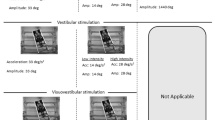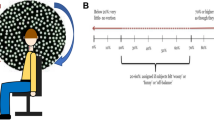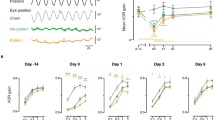Summary
Cats were submitted to repeated step stimulations either vestibular or optokinetic. Regardless of which of the two stimuli was used, dynamic modifications were observed in both vestibulo-ocular response and optokinetic after-nystagmus (OKAN). The progressive changes in post-rotational nystagmus and OKAN were quantified by measuring the duration of their primary phase. A parallel evolution of these two parameters was found. When repeated unidirectional vestibular stimulations were used, the same asymmetry was induced in both vestibuloocular responses and OKAN. These results support the hypothesis that the vestibulo-ocular and the optokinetic reflex share a common velocity storage mechanism, although alternative hypotheses cannot be excluded.
Similar content being viewed by others
References
Bond HW, Ho P (1970) Solide miniature silver-silver chloride electrodes for chronic implantation. Electroencephalogr Clin Neurophysiol 28: 206–208
Buizza A, Schmid R (1982a) Visual-vestibular interaction in the control of eye movement: mathematical modelling and computer simulation. Biol Cybern 43: 209–223
Buizza A, Schmid R (1982b) Models of visual vestibular interaction in oculomotor control: a review. In: Roucoux A, Crommelinck M (eds) Physiological and pathological aspects of eye movements. Junk, The Hague, pp 233–250
Clément G, Courjon JH, Jeannerod M, Schmid R (1981) Unidirectional habituation of vestibulo-ocular responses by repeated rotational or optokinetic stimulations in cat. Exp Brain Res 42: 34–42
Cohen B, Matsuo V, Raphan Th (1977) Quantitative analysis of the velocity characteristics of optokinetic nystagmus and optokinetic after-nystagmus. J Physiol 270: 321–344
Demer JL (1981) The variable gain element of the vestibulo-ocular reflex is common to the optokinetic system of the cat. Brain Res 229: 1–13
Demer JL, Robinson DA (1983) Different time constants for optokinetic and vestibular nystagmus with a single velocity storage element. Brain Res 276: 173–177
Dichgans J, Schmidt CL, Graf W (1973) Visual input improves the speedometer function in the vestibular nuclei of the goldfish. Exp Brain Res 18: 319–322
Fernandez C, Goldberg JM (1971) Physiology of peripheral neurons innervating semicircular canals of the squirrel monkey. II. Response to sinusoidal stimulation and dynamics of peripheral vestibular system. J Neurophysiol 34: 676–684
Haddad GM, Demer JL, Robinson DA (1980) The effect of lesions of the dorsal cap of the inferior olive on the vestibuloocular and optokinetic systems of the cat. Brain Res 185: 265–275
Henn V, Cohen B, Young LR (1980) Visual-vestibular interaction in motion perception and the generation of nystagmus. Neurosci Res Progr Bull 18(4). MIT Press, Cambridge MA
Jeannerod M, Magnin M, Schmid R, Stefanelli M (1976) Vestibular habituation to angular velocity steps in the cat. Biol Cybern 22: 39–48
Jell RM, Ireland DJ, Lafortune S (1985) Human optokinetic afternystagmus. Effects of repeated stimulation. Acta Otolaryngol 99: 95–101
Keller E, Precht W (1979) Visual-vestibular responses in vestibular nuclear neurons in intact and cerebellectomized, alert cat. Neuroscience 4: 1599–1613
Lisberger SG, Miles FA, Optican LM, Eighmy BB (1981) Optokinetic response in monkey: underlying mechanisms and their sensitivity to long-term adaptive changes in vestibuloocular reflex. J Neurophysiol 45: 869–890
Magnin M, Jeannerod M (1973) Fixation non-traumatique de la tête chez le chat éveillé. C R Séan Soc Biol 167: 996–998
Maioli C, Precht W (1984) The horizontal optokinetic nystagmus in the cat. Exp Brain Res 55: 494–506
Melvill Jones G, Milsum JH (1971) Frequency analysis of central vestibular nuclei activity resulting from rotational stimulation of the semicircular canals. J Physiol 219: 191–215
Raphan Th, Cohen B, Matsuo V (1977) A velocity storage mechanism responsible for optokinetic nystagmus (OKN), optokinetic afternystagmus (OKAN), and vestibular nystagmus. In: Baker R, Berthoz A (eds) Control of gaze by brainstem neurons. Elsevier/North-Holland, Amsterdam, pp 37–47
Raphan Th, Matsuo V, Cohen B (1979) Velocity storage in the vestibulo-ocular reflex arc (VOR). Exp Brain Res 35: 229–248
Robinson DA (1976) Adaptive gain control of the vestibuloocular reflex by the cerebellum. J Neurophysiol 39: 954–969
Robinson DA (1977) Vestibular and optokinetic symbiosis: an example of explaining by modelling. In: Baker R, Berthoz A (eds) Control of gaze by brainstem neurons. Elsevier/North-Holland, Amsterdam, pp 49–58
Schmid R (1985) Habituation of the vestibulo-ocular responses. In: Ron S, Schmid R, Jeannerod M (eds) Sensorimotor plasticity: theoretical experimental, and clinical aspects. Les Editions INSERM, Paris, pp 141–162
Schmid R, Jeannerod M (1985) Vestibular habituation: an adaptive process? In: Berthoz A, Melvill Jones G (eds) Adaptive mechanisms in gaze control. Elsevier, Amsterdam, pp 113–122
Skavenski AA, Blair SM, Westheimer G (1981) The effect of habituating vestibular and optokinetic nystagmus on each other. J Neurosci 1: 351–357
Takemori S (1974) The similarities of optokinetic after-nystagmus to the vestibular nystagmus. Ann Otol 83: 230–238
Waespe W, Kenn V (1977) Neuronal activity in the vestibular nuclei of the alert monkey during vestibular and optokinetic stimulation. Exp Brain Res 27: 523–538
Waespe W, Kenn V (1978) Reciprocal changes in primary and secondary optokinetic after-nystagmus (OKAN) produced by repetitive optokinetic stimulation in the monkey. Arch Psychiat Nervenkr 225: 23–30
Waespe W, Henn V (1979) The velocity response of vestibular nucleus neurons during vestibular, visual, and combined angular acceleration. Exp Brain Res 37: 337–347
Author information
Authors and Affiliations
Rights and permissions
About this article
Cite this article
Buizza, A., Courjon, J.H., Flandrin, J.M. et al. Cross-coupled effects of repeated vestibular and optokinetic stimulations on the dynamics of the vestibulo-ocular and optokinetic reflexes in the cat. Exp Brain Res 70, 209–215 (1988). https://doi.org/10.1007/BF00271861
Received:
Accepted:
Issue Date:
DOI: https://doi.org/10.1007/BF00271861




